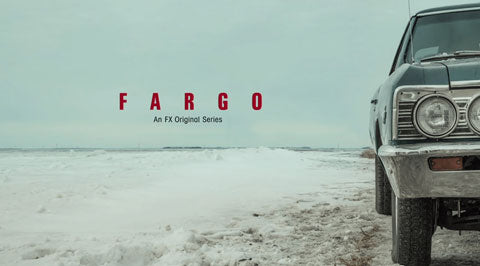Design of the Week | In Praise of Fargo

[Warning: spoilers aplenty.]
Ask and ye shall receive! A couple weeks ago I was lamenting the predictability of what I think of as MFA writing, evident in much contemporary literature, but also in pretty much every single TV show or film produced these days, even the independent features, while proclaiming the merits of gonzo endings. You can probably tell by some of the books we've published—The Orange Eats Creeps, Binary Star, Radio Iris, The Shanghai Gesture—I like to be goosed.
When I wrote that post a couple weeks ago and suggested it'd be cool if the climax of a story is interrupted by the sudden appearance of aliens, people familiar with the show undoubtedly assumed that I was referring to the second season of Fargo. Cause that's exactly what fucking happened! And I peed in my pants a little.
Clearly, Fargo's producers are embroiled in Hollywood and understand structurally how a show is supposed to transpire; aliens interrupting the big shoot-out are not it.
The second season really elevated the show. Fargo has always excelled at mood, and the cinematography is as essential to their storytelling as dialogue or setting. But the second season ambitiously sought to build on what they had already achieved, as though those involved would be bored by simply making another great season of a great show. That's an important distinction to make because most successful shows are only determined one season to the next to tighten their concept rather than pushing it farther afield.
There was also the introduction of this concept of language and communication, or rather miscommunication. Near the tail-end of the final episode, Hank talks about a language he has been inventing for years, which is his own private way of combating the evil of the world, which he believes is the result of miscommunication. There is also a scene with a pair of deaf boys playing catch, one of whom is frustrated but can't communicate that until he takes the baseball glove off his hand, and once he does, and is finally able to express himself, a pair of surly teenagers arrives and starts pounding him. On the other side you have the menacing killers—Lorne Malvo in season 1 and Mike Milligan in season 2—communicating perfectly in their deliberate drawls; it is always the seemingly innocent who stammer and get emotional. Then there's Ed, the Butcher of Luverne, who just before he dies on the floor of the walk-in freezer finally manages to put into words the realization that he and his wife Peggy were not meant to be together, a realization that was apparent to viewers from the very first episode. Perhaps the insinuation being that what lies at the root of all these horrific acts—the butterfly that whips the events into motion—is really just faulty communication.
I can't wait for season 3, sometime in 2017.


Comments